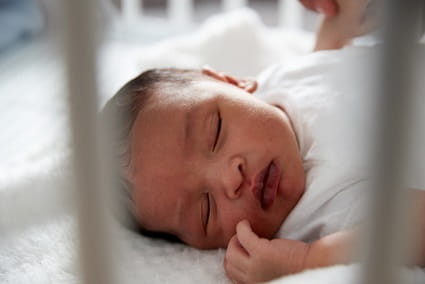Safe Sleep and Sweet Dreams

You’ve heard the expression, sleep like a baby, but how should a baby sleep? Some of us may hog the covers or end up diagonal in the bed by morning, but there are specific precautions parents need to take when sending their little one off to dreamland.
Safe Sleeping
The American Academy of Pediatrics (AAP) recommends that babies sleep on their back for naptime and bedtime. Research shows that a side position may cause your baby to roll from their side to their stomach, which may cause accidental suffocation. If you place your baby on their back and they inadvertently roll onto their stomach, you should try and return them to their back. Once your baby is comfortable rolling from their back to their stomach, then you don’t have to return them to their back. Your baby’s crib or bassinet should be free of any loose blankets, pillow, stuffed animals or bumpers. Swaddling your baby is okay when they’re sleeping; however, once your baby can roll around you should stop swaddling.
Co-Bedding
The AAP also recommends that the safest place for your baby to sleep is in your room, but not in your bed. Studies show that room sharing has been known to reduce the risk of sudden infant death syndrome (SIDS) by 50 percent. Room sharing also makes it easier for feeding, changing and watching your baby. AAP doesn’t recommend co-bedding with babies at any age.
SUID/SIDS
No one wants to think of the worse situation, but the truth is sudden unexpected infant death (SUID) is the leading cause of death among babies between 1 month and 1 year of age. SUID includes SIDS, accidental suffocation in a sleep environment and other deaths from unknown causes. The Centers for Disease Control and Prevention recommend placing your baby on their back for all sleep times, using a flat sleep surface covered by a fitted sheet, removing blankets and stuffed animals from the sleep area and placing your baby in your room for the first six months.
If you have questions about your baby’s sleep area or sleep habits, talk with your pediatrician.
